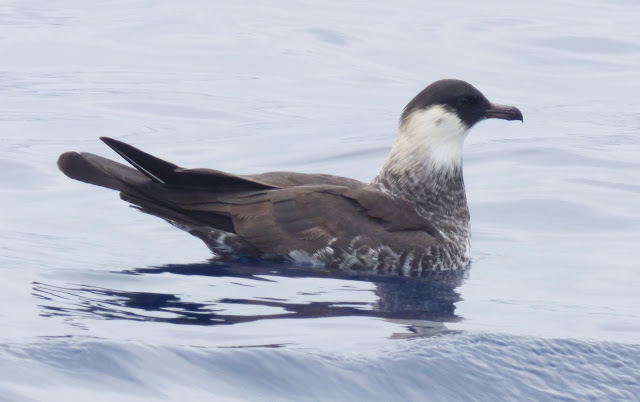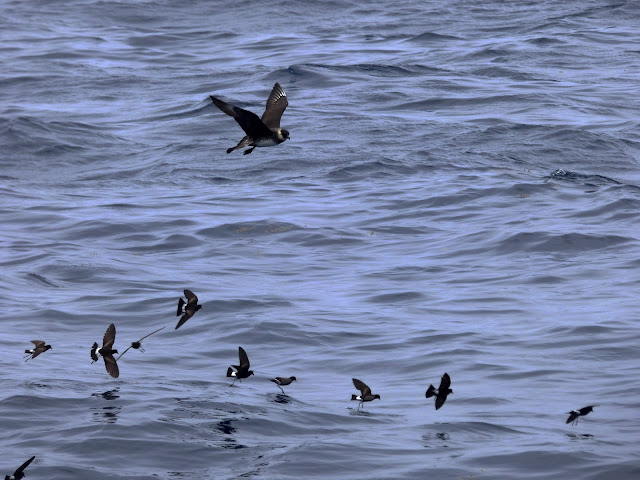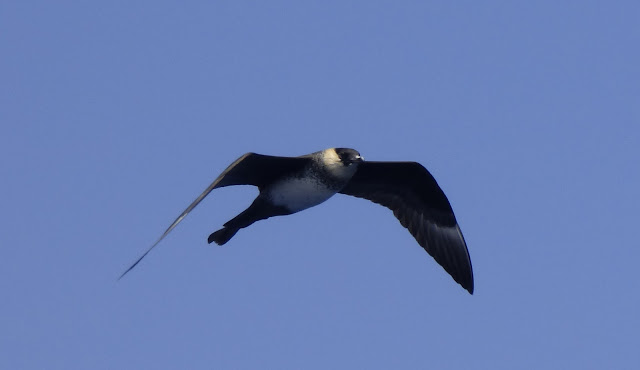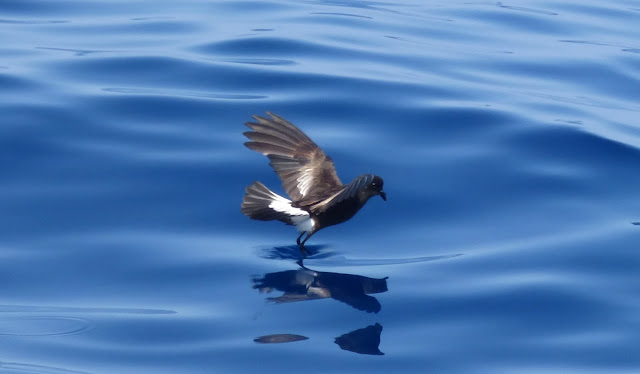Any serious ABA-area lister with the stomach for pelagic birding has to make at least one pilgrimage to Cape Hatteras to venture offshore with Brian Patteson. Hatteras provides convenient access to gulf stream waters and continental shelf break, with unparalleled opportunities for deep Atlantic Ocean bird species unlikely to be encountered anywhere else in North America.
The best chance to see the most elusive target species lies at the end of May when Brian runs his 'spring blitz,' with 11 consecutive trips. It represents a sort of mecca for elite North American birders. The Attu guides
with decades of Alaska vagrant-hunting under their belts come out here year after year, hoping for a mega-rarity or a better look at the
mega-rarity they glimpsed on a previous trip. One Canadian birder on board was sheepish about his ABA list of 'only' ~750. Another birder in town from Montana signed up for all 11 trips, hoping to sweep the table of rarities in one season. Other birders had arrived from Oregon, the British Isles and Austria, all well-seasoned twitchers keen for a rare chance to tick multiple life birds in a few days.
I enthusiastically took the opportunity to spot on the first three trips of this season. I've done plenty of spotting aboard the Stormy Petrel II, but this was my first time at it in May and under such pressure to perform. Luckily Brian and his first mate, Kate Sutherland do all the heavy lifting, and I had the sharp eyes and big lens of Mike Lanzone to help carry the spotting burden.
Day one was Pomarine Jaeger day. I'm not sure how many crossed our path throughout the day, but there was almost always one trailing the boat, taking futile swings at the scurrying Wilson's Storm-Petrels and dipping into the wake for chum.
 |
| Pomarine Jaeger |
 |
| Pomarine Jaeger |
 |
| Pomarine Jaeger and Wilson's Storm-Petrels |
Every now and again one would make a low pass over the bow just out of arms reach.
 |
| Pomarine Jaeger |
The biggest surprise of the day was a young Bridled Tern loafing around on flotsam. Spring is the breeding season for this species, so they are rather uncommon offshore until late summer.
 |
| young Bridled Tern |
Day 2 was another big one for kleptoparasitic species. We had a couple Parasitic Jaegers around the boat and then a pair of friendly South Polar Skuas. It was wild watching the Black-capped Petrels divebomb these birds.
 |
| Parasitic Jaeger (dark morph) |
 |
| South Polar Skua |
Just after the first of the dark Parasitic Jaegers appeared, a second odd dark bird showed up, but this one was a pterodroma--a Trindade Petrel! This is one of the rare gadfly petrels that we hope to see.
Several Arctic Terns braved our attendant skuas and jaegers and fed in the wake, giving close enough looks for all to tell them apart from the similar Common Terns which were also seen frequently.
 |
| Arctic Tern |
A few Arctic Terns had been recently blown onto shore in North Carolina by the passing of a tropical storm. I hadn't been able to chases these birds, so was glad to see them offshore and add them to my list. Apparently all you need to see them out on a pelagic in May is a bit of an easterly breeze.
 |
| Arctic Tern |
The east wind also seemed to bring out the Leech's and Band-rumped Storm-Petrels. We saw several of each on our second day.
On Day 3 a front arrived bringing much cooler weather and winds out of the north. This seemed to blow away the jaegers and skuas and most of the storm-petrels, but there seemed to be just as many Black-capped Petrels around, so we had a mind for pterodromas.
We had more arctic terns and the usual assortment of Sooty, Cory's and Audubon's Shearwaters--seen each day so far. But other than a few tantalizingly brief and/or distant glimpses of Trindade Petrel our day was looking to be a bit of a bust. But at 1:30, just as we were about to begin our run back to shore Brian shouted, "Fea's Petrel four o'clock!" In zipped a gray-backed petrel with dark underwings bouncing in and out of the swell. For a panicked few moments we shouted instructions on its rapid movements. It disappeared in the chum slick for a few moments before taking off again. I watched it bound off into the distance. It would appear above the horizon slightly smaller after each successive arc until it became a small dot and then disappeared.
Sometimes it takes some quick reflexes and sharp eyes to catch a glimpse of the rare petrels. When they come in to the boat they don't often stick around and pose for photos and are then miles away again in a moment. It boggles the mind to think of the hours of preparation and effort that go into an outside chance of a brief view of these elusive birds. I had been out on many pelagic trips out of Hatteras and until this moment Fea's Petrel had eluded me.
 |
| (the not-at-all rare, but crowd-pleasingly cute) Wilson's Storm-Petrel |
If you fancy your odds make sure to book in advance as the spring blitz trips always fill in a hurry. See
seabirding.com for more information. For far superior photos of some of these birds by Mike Lanzone and Kate Sutherland's accounts, see the seabirding blog:
Day 1,
Day 2,
Day 3.
For the first time on a pelagic, I followed ebird's suggestion of submitting a new checklist every so often while offshore. I found this to be rather tedious at first, but it has its rewards. Now I have a better understanding of the route we actually take on this trip.
 |
| eBird GPS fixes outlining the teardrop-shaped pelagic route |
I was surprised to find that a few of the points outside the inlet actually landed in what ebird considers to be Hyde County, so I got a few unexpected county ticks for my trouble (Arctic Tern and three shearwater species).









